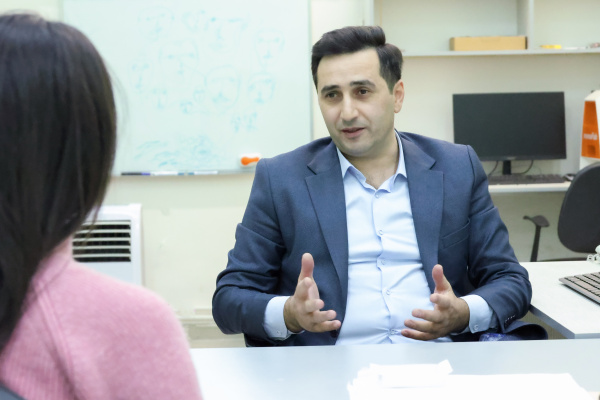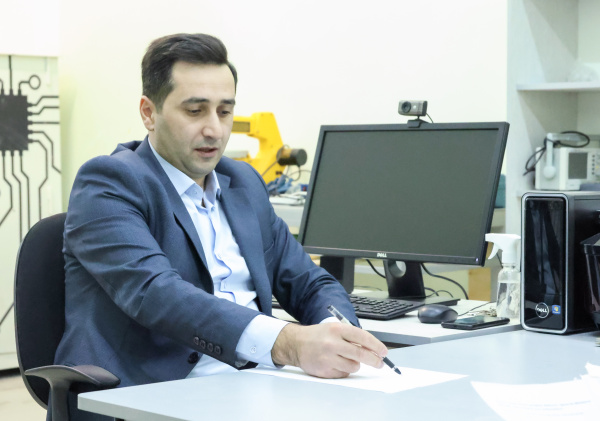December 16, 2024 | 14:40
Science
Education
Flying detector to detect greenhouse gases in atmospheric layers: YSU Professor Mikayel Aleksanyan's new scientific project
The increase in the concentration of greenhouse gases in the atmosphere contributes to global warming on Earth and causes anomalous climatic changes. This issue is central to the scientific research of Professor Mikayel Aleksanyan, Doctor of Technical Sciences, Head of the Center of Semiconductor Devices and Nanotechnologies at YSU Institute of Physics. His scientific project is aimed at developing innovative technologies that can assist in the continuous monitoring of air quality, particularly in terms of detecting greenhouse gases.

The scientific project "Synthesis and Application of One-Dimensional and Two-Dimensional Nanostructures in Flying Detectors for Detecting Greenhouse Gases in the Atmosphere" by Mikayel Aleksanyan has received funding as part of the "Prospective Research Projects-2024" competition.
The aim of this project is to synthesize and apply one-dimensional and two-dimensional nanostructures that can be used in specialized flying detectors for the detection of greenhouse gases in various layers of the atmosphere.
According to the head of the Center of Semiconductor Devices and Nanotechnologies at YSU Institute of Physics, the unique properties of nanostructures—such as high sensitivity, small size, rapid response, and flexibility—enable the development of devices capable of quickly and accurately detecting various gases in the atmosphere, thereby contributing to the resolution of environmental issues. Specifically, the detection of greenhouse gases (primarily carbon dioxide and methane) and precise measurement of their concentrations are considered critical in the fight against global warming.

"The main cause of global warming is the absorption and reflection of solar radiation by anthropogenic gases present in the atmosphere. The problem lies in the fact that such gases absorb part of the solar radiation reflected from the Earth's surface and partially re-emit it back toward the surface. As a result, more solar radiation remains here, increasing the average temperature of the Earth's surface. The emission of greenhouse gases into the atmosphere is a leading factor in the deterioration of air quality," noted M. Aleksanyan.
He added that these greenhouse gases, such as methane (CH₄), water vapor (H₂O), nitrous oxide (N2O), and, most notably, carbon dioxide (CO₂), are emitted into the atmosphere as a result of various industrial processes, the combustion of hydrocarbon fuels, fires, etc.
M. Aleksanyan mentioned that his research group has successfully synthesized carbon nanotubes and developed sensors based on them. Currently, scientists are continuously working to improve the growth technologies of nanotubes with the goal of producing other types of nanostructures. These new structures will be used to create sensors capable of detecting greenhouse gases, such as CO₂.
"We plan to develop a detector based on these sensors and attach it to unmanned aerial vehicles with appropriate parameters, which will take measurements in different layers of the atmosphere. The proposed technological methods for manufacturing greenhouse gas sensors extend beyond just monitoring climate change; they also have widespread applications in safety systems. Through continuous air quality monitoring, these sensors can help prevent anthropogenic disasters, such as explosions or poisoning. These sensors with such well-defined parameters are also successfully used in modern electronic noses, which are complex systems consisting of multiple sensors sensitive to various gases and capable of dynamically controlling both the quality of the surrounding air and different types of food products," emphasized the professor.

Regarding the specific properties of nanostructures for conducting research in this field, M. Aleksanyan highlighted that, in the past, volumetric semiconductors and three-dimensional structures were used in gas sensors, but these no longer meet modern requirements.
"We are facing increasingly stringent demands. Sensors must be more sensitive, faster, and more stable. Otherwise, we cannot compete with global scientific progress and meet the needs of the relevant markets. Today, experts in the field are replacing traditional materials and structures with modern nanostructures and composite compositions, as they offer far better characteristics (high sensitivity, speed, selectivity, stability, flexibility, etc.)," he concluded.
Professor Mikayel Aleksanyan, who has extensive experience in the growth of nanostructures and the development of gas sensors, is the author of more than 60 scientific works and educational-methodological manuals. He holds 6 patents and has carried out 10 grant projects.
He emphasized that the development of this field requires a number of conditions, including financial support, the involvement of young researchers, and continuous dedicated work. His scientific project will not only contribute to the development of high technologies in the field of physics but will also promote the development of future projects aimed at addressing global environmental challenges effectively.

